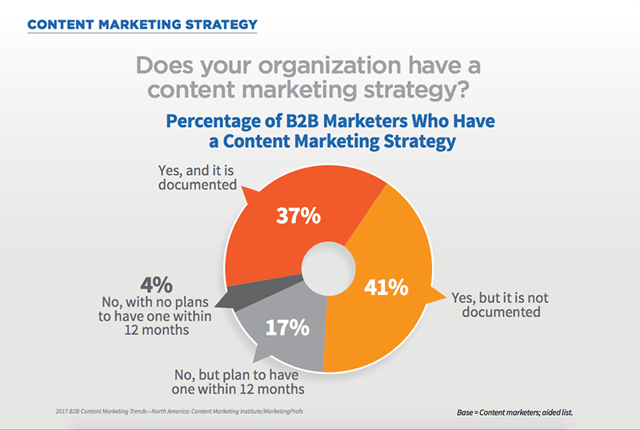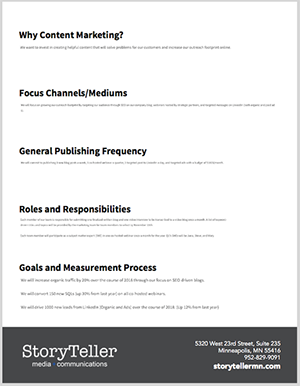Skol Minnesota: 7 Lessons Marketers Can Learn from the Vikings
It's hard to live in Minnesota without relating everything to the Minnesota Vikings these days. In case you missed it, the Vikings beat the New...
6 min read
 Kevin Page
:
Sep 22, 2017 6:30:00 AM
Kevin Page
:
Sep 22, 2017 6:30:00 AM

Do you shudder when you see the phrase “develop your yearly marketing strategy”? These often lengthy and seemingly tedious documents have been a long-held tradition among marketers. Or at least it is in theory...
Content Marketing Institute’s 2017 Report found that 63% of all marketers they surveyed don’t have a well-documented content strategy. However, out of the most successful companies surveyed, 61% did have a documented strategy.

Some people, like CoSchedule CEO Garrett Moon, have even called for the death of rigid, written strategies. In his article, Moon suggested that businesses would be better off following the example of agile startups who use the Lean Startup Model for their marketing efforts.
In his article, Moon states, “The thing about the word ‘strategy’ is that it implies deep thinking and forethought as if there is a 30-page Google Doc somewhere outlining our every move. It’s what used to be called the “marketing plan,” but no matter what we call it now, you probably don’t have one. Even worse, you probably feel guilty about it.”
However, I’d argue that your content marketing strategy doesn’t have to be a crazy 30-page, in-depth document that nobody actually follows. It’s extremely important that you agree on tactics and direction that support your company’s goals. So… a strategy.
Without a clear plan of where you want to go and how you are going to get there, many marketers fall back to gut feel, shiny objects, or the new marketing technologies that are ever-present in our industry.
The truth is that the landscape of marketing is so much more vast than it ever has been before and content marketing is only one slice of it, albeit an ever-expanding slice.
Gone are the days of Donald Draper and marketing strategies that included 3 channels. Today, we have our own blogs, industry blogs, forums, live streaming, video marketing, print, radio, TV, news centers, press releases, webinars, emails, Facebook, Twitter, Instagram, YouTube, LinkedIn, Google+, Pinterest, Snapchat… the list goes on and on.
And while you might be able to look at this list and rule out some channels for your business, it’s important to know, without a doubt, which ones are the most successful for your company today and which ones represent good opportunities for the future.
All of this can be really overwhelming, which is why so many companies go through weeks, months and years without ever stopping to consider what operating without a strategy could really mean for the bottom line of their business.
The same report from Content Marketing Institute found that 87% of the least effective marketers don’t have a documented strategy. Even worse than that, only 2% of the least effective marketers said that their content marketing was very effective for their company.

The bottom line is this: without a well-documented, targeted strategy, your content marketing is just empty tactics that take lots of time and effort and drive minimal results.
Hey, if what you are doing is working for you, DON’T CHANGE IT. But I’d venture to guess that if you are reading this blog, there’s probably some room for growth when it comes to your content strategy.

As HubSpot puts it, your content marketing strategy is basically the “management of pretty much any tangible media that you create and own — written, visual, downloadable.”
Click here to download our quick Content Marketing Strategy worksheet
Creating a strategy that drives results is going to be different for every company and every industry, but here are some basic principles that can help you create an effective strategy while also avoiding the dreaded 30-page marketing diatribe that no one will read or follow.
Don’t let the daunting idea of a giant, all-inclusive document keep you from putting something down on paper. Start with the goal of making a one-page strategy, if it gets a little longer, that’s ok. If it starts to creep past 4 or 5 pages, stop and ask yourself if all those details are really necessary and relevant.
Your company probably has goals for the year or the quarter, look at those first. Break it down into more digestible chunks like quarters or months and then compare them to what you are doing today.
Work on setting realistic, achievable goals for your marketing strategy that are laser-focused on helping meet your business goals.
Look back at your data and analytics from previous campaigns and content and look at what has created the most qualified leads and customers.
Don’t be afraid to say no to something if it doesn’t seem like it will help you meet your objectives.
Your personas represent your target audience. If you don’t understand the motivations and pain points of your customers, creating content that appeals to them is going to be a tough uphill battle.

If you don’t have defined target buyer personas that change the way your company does business, I strongly suggest taking the time to go through this webinar that will walk you through the steps to creating effective personas and also give you a template to define and document your target audiences in a way that will help shape your content marketing strategy.
Don’t let the long and ever-growing list of possible marketing channels overwhelm you. The truth is, every company is really going to have 1-5 tactics that work measurably better than all the other ones.
If you don’t have any idea which ones will work for you, do a little research about what has worked well in your industry:
A content marketing strategy is not the same as a content plan. Your strategy exists to get general alignment between your marketing team and your upper management. While your specific tactics might ebb and flow throughout the year based on new functionality, new metrics, and successful campaigns, the high-level goals should not change.
Find a way to regularly report on your overall goals. At StoryTeller, we use the EOS traction process and track our specific goals as part of our scorecard. Whether it’s with a weekly, monthly, or quarterly report, state the goals you set as part of your content marketing strategy and then document your progress towards those goals.
Reporting your progress to your leadership team will keep you accountable to the goals you set out to reach, it also helps you get more creative about how to meet those goals so you can do your part to help meet the company revenue targets.
Once you have defined your general content marketing strategy, use that to create a specific, time-oriented plan that includes due dates, publish dates, etc.
Break down each of the specific steps in the process to make sure that you have enough time to tackle everything that you’ve committed to for the year.
Once you’ve got all of this down on paper, it’s important to stick to it. Bring the strategy document with you to meetings and remind your upper management what your initial plan was and why. If a new strategy or tactic is getting thrown in the mix, ask if they are willing to drop one of your other tactics in order to make room for this one (or hire a new member to join your team).
Remember that you only have a finite amount of time every single day. It’s important to recognize that you can’t do everything and do it well. By taking time to strategically focus your direction and tactics you’ll be able to get better results by doing a smaller, more focused group of tactics.

It's hard to live in Minnesota without relating everything to the Minnesota Vikings these days. In case you missed it, the Vikings beat the New...

People have been talking about the power of digital marketing for years. I've come to realize, though, that most of that talk is all about aligning...

Clusters and silos and pillars, oh my! No need to click your red slippers together–just sit back, relax, and we’ll help you unpack some of the most...